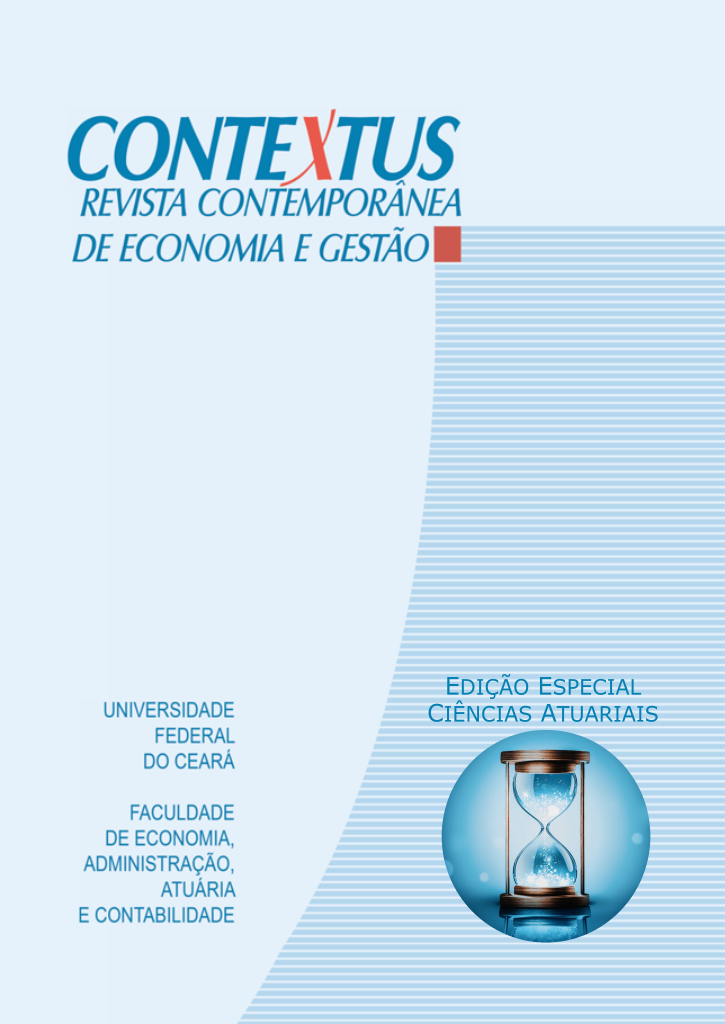Estimacion de la provision IBNR utilizando Números Fuzzy Gaussianos
DOI:
https://doi.org/10.19094/contextus.2023.83343Palabras clave:
provisiones técnicas, lógica fuzzy, números fuzzy, IBNR, estimaciónResumen
El estudio tuvo como objetivo proponer un nuevo enfoque para el método chain-ladder mediante el uso de Números Fuzzy Gaussianos. Por tanto, el texto introduce conceptos y establece nuevas perspectivas que permiten no solo el uso de este tipo de números fuzzy en el contexto de las provisiones técnicas, así como también en otras áreas del conocimiento, corroborando así para la expansión de la adopción de la lógica fuzzy en general. Los resultados indican que la adopción del método propuesto ofrece grandes beneficios en comparación con el enfoque tradicional y trabajos previos que exploran otros tipos de números fuzzy
Citas
Andrés Sánchez, J., & Terceño Gómez, A. (2003). Applications of Fuzzy Regression in Actuarial Analysis. Journal of Risk and Insurance, 70(4), 665-699. https://doi.org/10.1046/j.0022-4367.2003.00070.x
Andrés-Sánchez, J. (2006). Calculating Insurance claim reserves with fuzzy regression. Fuzzy Sets and Systems, 157(23), 3091-3108. https://doi.org/10.1016/j.fss.2006.07.003
Andrés-Sánchez, J. (2012). Claim reserving with fuzzy regression and the two ways of anova. Applied Soft Computing, 12(8), 2435-2441. https://doi.org/10.1016/j.asoc.2012.03.033
Andrés-Sánchez, J. (2016). Fuzzy regression analysis: An actuarial perspective. In C. Kahraman & Ö. Kabak (Eds). Fuzzy Statistical Decision-Making, (pp. 175-201). Springer, Cham. https://doi.org/10.1007/978-3-319-39014-7_11
Antonio, K., & Plat, R. (2013). Micro-level stochastic loss reserving for General Insurance. Scandinavian Actuarial Journal, 2014(7), 649-669. https://doi.org/10.1080/03461238.2012.755938
Bojadziev, G., & Bojadziev, M. (1995). Fuzzy sets, fuzzy logic, applications. World Scientific.
Bornhuetter, R. L., & Ferguson, R. E. (1972, November). The actuary and IBNR. Proceedings of the casualty actuarial Society, 59(112),181-195.
Carvalho, B. D. R. D., & Carvalho, J. V. D. F. (2019) Uma abordagem estocástica para a mensuração da incerteza das provisões técnicas de sinistros. Revista Contabilidade & Finanças, 30(81), 409-424. https://doi.org/10.1590/1808-057x201907860
Chakraverty, S., Sahoo, D. M., & Mahato, N. R. (2019). Defuzzification. Concepts of Soft Computing, 117-127. https://doi.org/10.1007/978-981-13-7430-2_7
Christofides, S. (1997). Regression models based on log-incremental payments. Claims Reserving Manual, Institute of Actuaries Volume 2. D5.16-D5.17.
Chukhrova, N., & Johannssen, A. (2017). State space models and the Kalman-filter in stochastic claims reserving: Forecasting, filtering and smoothing. Risks, 5(2), 30. https://doi.org/10.3390/risks5020030
Delong, Ł., Lindholm, M., & Wüthrich, M. V. (2021). Collective reserving using individual claims data. Scandinavian Actuarial Journal, 2022(1), 1-28. https://doi.org/10.1080/03461238.2021.1921836
Derrig, R. A., & Ostaszewski, K. M. (1999). Fuzzy Sets Methodologies in Actuarial Science. In H. J. Zimmermann (Ed.). Practical Applications of Fuzzy Technologies (pp. 531-553). Springer, Boston, MA. https://doi.org/10.1007/978-1-4615-4601-6_16
Dutta, P., & Limboo, B. (2017). Bell-shaped Fuzzy Soft Sets and Their Application in Medical Diagnosis. Fuzzy Information and Engineering, 9(1), 67-91. https://doi.org/10.1016/j.fiae.2017.03.004
England, P. D., & Verrall, R. J. (2002). Stochastic claims reserving in general insurance. British Actuarial Journal, 8(3), 443-544. http://www.jstor.org/stable/41141552
Gonzalez, A., Pons, O., & Vila, M. (1999). Dealing with uncertainty and imprecision by means of fuzzy numbers. International Journal of Approximate Reasoning, 21(3), 233-256. https://doi.org/10.1016/s0888-613x(99)00024-9
Hanss, M. (2005). Applied Fuzzy Arithmetic: An Introduction with Engineering Applications. Springer.
Heberle, J., & Thomas, A. (2014). Combining chain-ladder claims reserving with fuzzy numbers. Insurance: Mathematics and Economics, 55, 96-104. https://doi.org/10.1016/j.insmatheco.2014.01.002
Heberle, J., & Thomas, A. (2016). The fuzzy Bornhuetter–Ferguson method: an approach with fuzzy numbers. Annals of Actuarial Science, 10(2), 303-321. https://doi.org/10.1017/s1748499516000117
Kubrusly, J., Lopes, H., & Veiga, Á. (2008). Um método probabilístico para cálculo de reservas do tipo IBNR. Revista Brasileira de Risco e Seguro, 4(7), 17-46.
Lee, K. H. (2004). First Course on Fuzzy Theory and Applications (Advances in Intelligent and Soft Computing, 27). (2005th ed.). Springer.
Mack, T. (1993). Distribution-free Calculation of the Standard Error of Chain Ladder Reserve Estimates. ASTIN Bulletin, 23(2), 213-225. https://doi.org/10.2143/ast.23.2.2005092
Mano, C. C. A., & Ferreira, P. P. (2009). Aspectos atuariais e contábeis das provisões técnicas (1st ed.). Escola Nacional de Seguros - Funenseg.
Mano, C. C. A., & Ferreira, P. P. (2018). Aspectos atuariais e contábeis das provisões técnicas (2nd ed.). Escola Nacional de Seguros - Funenseg.
Maturo, F., & Fortuna, F. (2016). Bell-Shaped Fuzzy Numbers Associated with the Normal Curve. In T. Di Battista, E. Moreno & W. Racugno, (Eds.), Topics on Methodological and Applied Statistical Inference (pp. 131-144). Springer, Cham. https://doi.org/10.1007/978-3-319-44093-4_13
Shapiro, A. F. (2004). Fuzzy logic in insurance. Insurance: Mathematics and Economics, 35(2), 399-424. https://doi.org/10.1016/j.insmatheco.2004.07.010
Straub, E., & Grubbs, D. (1998). The Faculty and Institute of Actuaries Claims Reserving Manual. volume 1 and 2. ASTIN Bulletin The Journal of the IAA, 28(2), 287-289. https://doi.org/10.1017/s0515036100012472
Wit, G. (1982). Underwriting and uncertainty. Insurance: Mathematics and Economics, 1(4), 277-285. https://doi.org/10.1016/0167-6687(82)90028-2
Wüthrich, M. V. (2018). Machine learning in individual claims reserving. Scandinavian Actuarial Journal, 2018(6), 465-480. https://doi.org/10.1080/03461238.2018.1428681
Wüthrich, M. V., & Merz, M. (2008). Stochastic Claims Reserving Methods in Insurance. Wiley.
Zadeh, L. (1965). Fuzzy sets. Information and Control, 8(3), 338-353. https://doi.org/10.1016/s0019-9958(65)90241-x
Publicado
Cómo citar
Número
Sección
Licencia
Derechos de autor 2023 Journal: only for the 1st publication

Esta obra está bajo una licencia internacional Creative Commons Atribución-NoComercial 4.0.
Os autores, no ato da submissão, aceitam a declaração abaixo:
Nós autores mantemos sobre nosso artigo publicado os direitos autorais e concedemos à revista Contextus o direito de primeira publicação, com uma licença Creative Commons na modalidade Atribuição – Não Comercial 4.0 Internacional, a qual permite o compartilhamento com reconhecimento da autoria e da publicação inicial nesta revista.
Temos ciência de estarmos autorizados a assumir contratos adicionais separadamente, para distribuição não exclusiva da versão do trabalho publicada nesta revista (ex.: publicar em repositório institucional ou como capítulo de livro), também com reconhecimento tanto da autoria, quanto da publicação inicial neste periódico.
Atestamos que o artigo é original ou inédito, não foi publicado, até esta data, em nenhum periódico brasileiro ou estrangeiro, quer em português, quer em versão em outra língua, nem está encaminhado para publicação simultânea em outras revistas.
Sabemos que o plágio não é tolerado pela revista Contextus e asseguramos que o artigo apresenta as fontes de trechos de obras citadas, incluindo os de qualquer trabalho prévio produzido e publicado pelos próprios autores.









3.png)


1.jpg)



1.jpg)


1.jpg)






.jpg)



1.jpg)

1.jpg)


1.jpg)

1.jpg)
1.jpg)
2.png)




1.jpg)
2.jpg)

1.jpg)





1.jpg)


1.jpg)
1.jpg)
